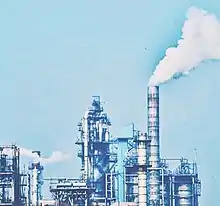Barauni Refinery
Barauni Refinery in the Begusarai District Bihar state of India was built in collaboration with the Soviet Union at a cost of Rs.49.4 crores and went on stream in July, 1964.[1][2][3] The initial capacity of 1 million tonnes per year was expanded to 3 million tonnes per year by 1969. The present capacity of this refinery is 6.100 million tonnes per year. Indian Oil Corporation has planned to expand its capacity from 6 million tonnes per year to 9 million tonnes per year at the cost of $1.94billion.[4] A Catalytic Reformer Unit (CRU) was also added to the refinery in 1997 for production of unleaded motor spirit. Projects are also planned for meeting future fuel quality requirements.

Barauni Refinery was built in collaboration with Russia and Romania. Situated 125 kilometres (78 mi) from Patna, it was built with an initial cost of Rs 49.40 crore. Barauni Refinery was commissioned in 1964 with a refining capacity of 1 million tonnes per year and it was dedicated to the Nation by the then Union Minister for Petroleum, Prof. Humayun Kabir in January 1965. After de-bottlenecking, revamping and expansion project, its capacity today is 6 million tonnes per year. Matching secondary processing facilities such Residue Fluidized Catalytic Cracker (RFCC), Diesel Hydro treating (DHDT), Sulphur Recovery Unit (SRU) have been added. These state of the art eco-friendly technologies have enabled the refinery to produce environment- friendly green fuels complying with international standards.
Barauni Refinery was initially designed to process low sulphur crude oil (sweet crude) of Assam. After establishment of other refineries in the Northeast, Assam crude is unavailable for Barauni . Hence, sweet crude is being sourced from African, South East Asian and Middle East countries like Nigeria, Iraq and Malaysia. The refinery receives crude oil by pipeline from Paradip on the east coast via Haldia. With various revamps and expansion projects at Barauni Refinery, capability for processing high-sulphur crude has been added — high-sulphur crude oil (sour crude) is cheaper than low-sulphur crudes — thereby increasing not only the capacity but also the profitability of the refinery.
See also
References
- http://articles.timesofindia.indiatimes.com/2002-01-14/india-business/27115335_1_barauni-refinery-oil-companies-capacity
- http://articles.timesofindia.indiatimes.com/2002-11-28/patna/27321644_1_barauni-refinery-entry-tax-barauni-unit
- http://articles.timesofindia.indiatimes.com/2005-02-25/patna/27858689_1_barauni-refinery-despatch-production
- https://www.indiainfoline.com/article-amp/news-top-story/indian-oil-corporation-approves-expansion-of-barauni-refinery-stock-slips-3-120013100487_1.html
